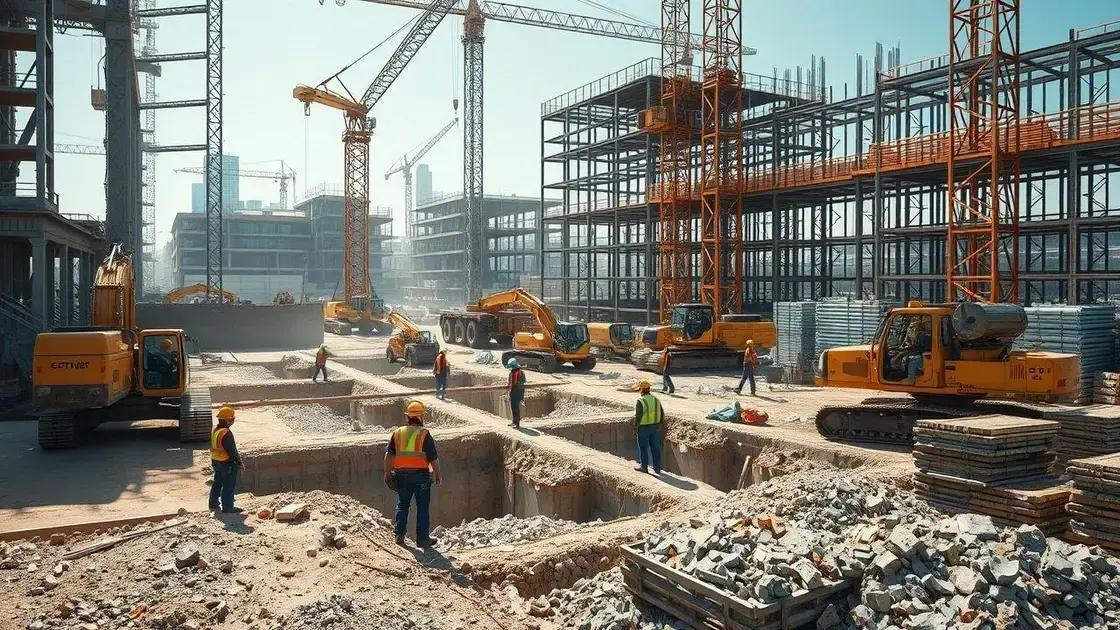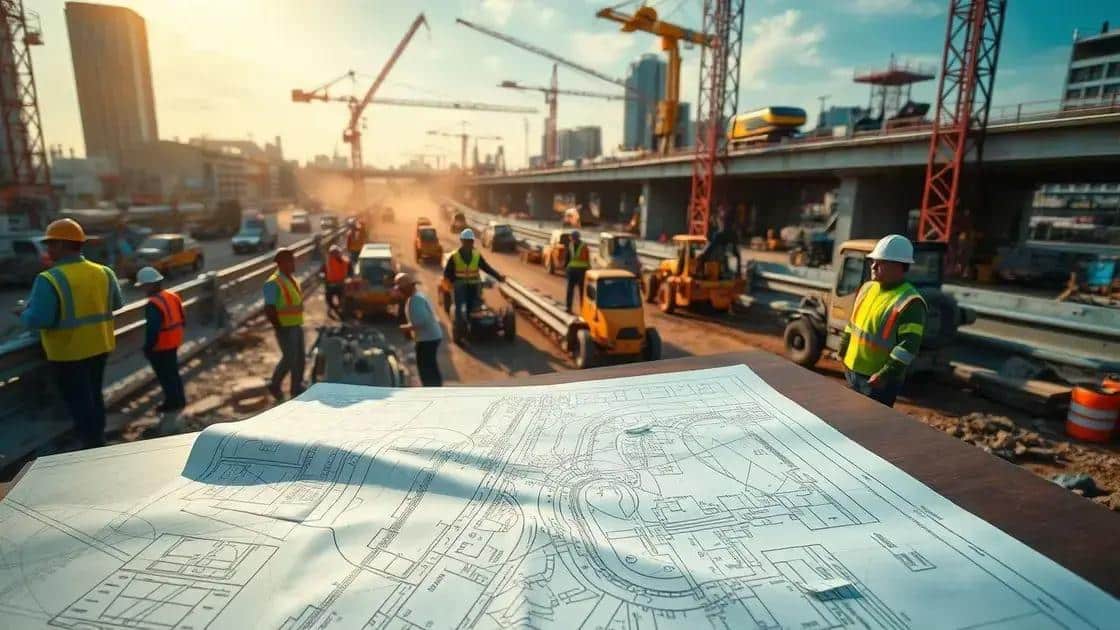Bipartisan infrastructure bill passes in Senate with impact

The bipartisan infrastructure bill aims to improve roads, bridges, and public transit, while creating jobs and promoting sustainable practices to enhance local economies across the nation.
Bipartisan infrastructure bill passes in Senate, marking a significant step toward rebuilding America’s roads and bridges. What does it mean for your community? Let’s dive in.
Overview of the bipartisan infrastructure bill
The bipartisan infrastructure bill represents a historic effort to improve America’s aging infrastructure. With an emphasis on efficient transportation and broader access to essential services, this legislation aims to revitalize many areas across the country.
Key Goals of the Bill
This infrastructure bill focuses on several key goals. Primarily, it seeks to tackle the pressing issues of road safety and quality. There are also significant allocations towards public transport systems.
- Investment in roads and bridges
- Funding for public transit expansion
- Enhancements to broadband access
- Improvements in water and sewage systems
Additionally, the bill underscores the importance of embracing sustainable practices. By incorporating green technology, it aims to reduce environmental impact while enhancing infrastructure efficiency.
Funding and Implementation
The funding structure of this bill is particularly noteworthy. It utilizes a combination of federal, state, and local resources. This approach not only ensures immediate improvements but also promotes long-term sustainability.
Moreover, the collaboration between both political parties signifies a commitment to national progress. As communities receive these funds, they can begin to see tangible improvements in their everyday lives.
Investment in infrastructure leads to job creation. As such, the ripple effects of this bill can bring substantial economic improvements. It creates opportunities for workers across various sectors, inviting innovative solutions to current infrastructure challenges.
Key features and funding allocations

The bipartisan infrastructure bill includes several key features designed to address the nation’s critical needs. These features not only aim to improve roads and bridges but also to enhance utilities and transportation systems.
Major Funding Allocations
One of the most significant aspects of this bill is the way that funds are allocated. A large portion targets road and bridge repairs, which are essential for safe travel. Furthermore, public transportation systems receive much-needed support to enhance accessibility.
- Approximately $110 billion for roads, bridges, and major projects
- Investment of $39 billion to modernize public transit
- About $65 billion allocated for broadband expansion
- Funding for water infrastructure improvements
These allocations are critical for ensuring that each community can benefit. They create safer environments and promote faster travel times.
Innovative Initiatives
Additionally, the bill encourages innovative initiatives like eco-friendly energy solutions. By including funds for renewable energy projects, it promotes sustainability alongside infrastructure improvements. This dual approach aims to boost both the economy and environmental efforts.
As states start utilizing these funds, they can expect to see improved infrastructure. This process will enhance day-to-day life for many Americans, creating a ripple effect of benefits throughout the economy. Thus, investing in infrastructure is not just about roads; it’s about building a stronger future for everyone.
Potential impact on local economies
The bipartisan infrastructure bill is expected to have a substantial impact on local economies. By investing in infrastructure, communities can improve their overall quality of life and boost economic growth.
Job Creation Opportunities
First and foremost, one of the most direct benefits is job creation. The bill is designed to create thousands of new jobs in various sectors. Construction, engineering, and maintenance will see a significant increase in demand.
- Construction jobs for road and bridge projects
- Positions in public transit systems
- Jobs focused on utility upgrades
- Opportunities in green energy initiatives
These jobs not only provide employment but also improve local economies by increasing consumer spending.
Supporting Local Businesses
As infrastructure improves, local businesses also benefit. Better roads and public transport systems allow customers to reach businesses more easily. This connectivity drives sales and encourages new enterprises to emerge in the area.
Moreover, improved infrastructure attracts larger companies looking to expand or relocate. This can lead to more investments and long-term economic stability.
Enhanced Quality of Life
The positive effects extend beyond just economic figures. When communities invest in their infrastructure, they also enhance the overall quality of life for residents. Better roads lead to safer travel, while upgraded public transit increases mobility for all citizens.
Access to reliable utilities ensures that everyone has the basic services they need. In turn, this fosters a sense of community and encourages residents to engage more actively in local events and initiatives.
Future implications and follow-up actions

The bipartisan infrastructure bill has significant future implications for communities and the economy. By addressing long-standing infrastructure needs, this legislation sets the stage for transformative change.
Long-Term Economic Growth
One major implication is the potential for sustained economic growth. Improved infrastructure directly influences productivity. As roads, bridges, and public transit systems become more efficient, businesses can operate more effectively, leading to economic expansion over time.
- Increased access allows businesses to reach broader markets.
- Enhanced logistics reduce costs for companies.
- Job creation leads to higher disposable income.
- Investment in infrastructure attracts new businesses to the area.
These outcomes create a cycle of prosperity that benefits communities across the nation.
Environmental Considerations
Furthermore, the bill emphasizes sustainable and eco-friendly infrastructure projects. This type of investment is essential for addressing climate change concerns.
Utilizing green technology in construction can help reduce carbon footprints and promote cleaner energy sources. By prioritizing sustainability, communities can benefit not just economically, but also environmentally. This effort ensures that future generations inherit a healthy planet.
Follow-Up Actions and Monitoring
To maximize the impact of the infrastructure bill, effective monitoring and follow-up actions are necessary. Local governments need to implement plans for how these funds will be utilized.
Moreover, community engagement is crucial. Residents should have a voice in projects that affect them. Regular updates on progress ensure transparency and accountability. This approach fosters trust between lawmakers and constituents, encouraging ongoing support for future infrastructure initiatives.
FAQ – Frequently Asked Questions about the Bipartisan Infrastructure Bill
What are the main goals of the bipartisan infrastructure bill?
The main goals include improving roads and bridges, enhancing public transit, and investing in utilities and broadband expansion.
How will this bill create jobs?
The bill is expected to create thousands of jobs in construction, engineering, and maintenance as infrastructure projects are initiated.
What impact will the bill have on local economies?
The bill will boost local economies by improving connectivity, attracting new businesses, and increasing consumer spending.
How does the bill address environmental concerns?
It promotes sustainable practices in infrastructure projects, focusing on reducing carbon footprints and utilizing renewable energy sources.





